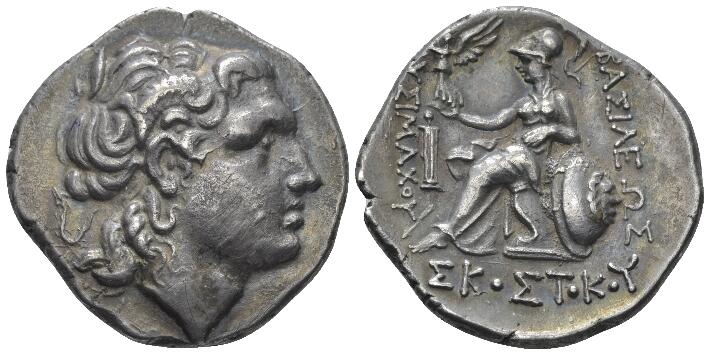Cabyle? (Skostokos, types of Lysimachus), silver, tetradrachms (285-281 BCE) Fischer-Bossert
From SILVER
285 BCE - 281 BCE Silver 4,598 kg
Description
| ObverseInscription or printing placed on the obverse.: | Diademed head of the deified Alexander r., with horn of Ammon |
| ReverseInscription or printing placed on the reverse.: | ΣKOΣTOKOY in exergue (Greek).Athena Nikephoros seated l., arm resting on shield, transverse spear in background, herm to inner l. |
Mint and issuing power
| MintIdentifies the place of manufacture or issue of a numismatic object.: | Cabyle | Ancient regionAncient region.: | Thrace | Modern countryModern country: Bulgaria | AuthorityIdentifies the issuing power. The authority can be "pretended" when the name or the portrait of X is on the coin but he/she was not the issuing power. It can also be "uncertain" when there is no mention of X on the coin but he/she was the issuing power according to the historical sources: | Skostokos (vassal of Lysimachus or ruler in Thrace ?), Lysimachus (Macedonian officer, diadochus and king, c. 360-281 BC) |
Chronology
| FromIdentifies the initial date in a range assigned in a numismatic context. | 285 BCE | toIdentifies the final date in a range assigned in a numismatic context.. | 281 BCE | PeriodTime period of the numismatic object.: Hellenistic 323-30 BC |
Physical description
| MetalThe physical material (usually metal) from which an object is made.: | Silver |
Median weightMedian of the weights of numismatic objects (in grams). in grams | 16.60 | DenominationTerm indicating the value of a numismatic object. Examples: tetradrachm, chalkous, denarius.: | tetradrachm |
StandardStandard.: | Attic |
Image

S1600 Skostokos Lysimachus.jpg [1]
References
| Die study referencePublication of the study: | Fischer-Bossert 20051Fischer-Bossert 2005 | ||
| Coin series referenceReference to coin series study: | |||
Obverse dies distribution
| FrequencyFrequency of specimen in distribution. ᵖ | Number of obversesNumber of obverse dies. ᵖ (o) | % (o) | Number of coinsNumber of coins. (n) | % (n) | Die nameName(s) of the die(s). |
| 1 | 6 | 46.15 | 6 | 7.14 | 2, 7, 9, 10, 12, 13 |
| 2 | 1 | 7.69 | 2 | 2.38 | 11 |
| 5 | 2 | 15.38 | 10 | 11.9 | 4, 5 |
| 6 | 1 | 7.69 | 6 | 7.14 | 8 |
| 9 | 1 | 7.69 | 9 | 10.71 | 6 |
| 11 | 1 | 7.69 | 11 | 13.1 | 3 |
| 40 | 1 | 7.69 | 40 | 47.62 | 1 |
| Total | 13 of 13 | 99.98 | 84 of 84 | 99.99 |
Reverse dies distribution
no distribution is available
Quantification
| Number of obversesNumber of obverse dies. ᵖ (o) | 13 | Number of singletons (o1)The number of singleton coins. ᵖ | 6 |
| Number of reverse diesNumber of reverse dies. (r) | 27 | Number of coinsNumber of coins. (n) | |
| Coins per obverse dieNumber of coins per obverse die. (n/o) | Coins per reverse dieNumber of coins per reverse die. (n/r) | ||
| Reverse per obverse ratioRatio of obverse dies divided by reverse dies. (r/o) | 2.08 | Percentage of singletons (o1)number of coins (n) divided by the number of singletons (o1) ᵖ | 46.15 % |
| Original number of dies (O) (Carter 1983 formula)The estimation of the number of coins according to Carter 1983 ᵖ | Expression error: Unexpected / operator. | Coins struck if 20,000 as average productivity per dieCoins made if the average productivity for obverses (according to Carter) is 20,000. ᵖ | |
| Original number of dies (O) (Esty 2011 formula)The estimation of the number of coins according to the singleton formula in Esty 2011 ᵖ (O) | Survival rate if 20,000 as average productivity per dieSurvival rate if average productivity is 20,000. ᵖ | 0.00030 | |
| Coverage (o = % of O) (Esty 1984 formula)Esty 1984 - coverage (% of O) ᵖ (o = % of O) | % | Die productivity if survival rate 1/2,000Average productivity if survival rate is 1/2,000. ᵖ | |
| Weight of silver (in kg) if 20,000 coins per die (O = Carter formula)Carter 1983 * Median weight * 20000 (*10 if gold or electrum) ᵖ | 4,598 kg | Die productivity if survival rate 1/5,000Average productivity if survival rate is 1/5,000. ᵖ |
Remarks
References
- ^ Fischer-Bossert, Wolfgang (2005), "Die Lysimacheier des Skostokos", Revue belge de numismatique, 151, p. 49-74.